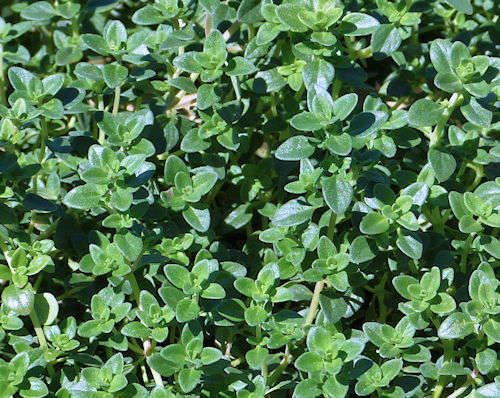Growing Thymus:
Thyme Species
Description
Form: Herbaceous stems, prostrate, growing from a woody base (subshrub), mat-like or mounded.
Lifespan: Perennial.
Leaf retention: Evergreen in mild winters.
Growth rate: Slow to rapid, depending on cultivar.
Mature Size: 2-8" (5-21cm) high and 12-18" (30-46cm) wide.
Flowers: Small, usually clustered, purple, pink, red or white, edible.
Bloom: Spring or summer.
Fruit: A dry fruit capsule that splits into single-seeded parts when ripe (schizocarp).
Leaves: Small, green, smooth or fuzzy, aromatic when crushed, usually edible. Several thyme cultivars, such as Caraway, Lime, and Mint, have a fragrance, but no cooked flavor. Only two cultivars have a flavor that survives cooking, and are listed below.
Stems: Thin, wiry, herbaceous, growing from an initially herbaceous base that becomes woody with age. On some cultivars the stems become woody with age as well. The stems grow roots where their leaf nodes touch moist soil.
Roots: Taproot.
Cultivars of Note:
Thymus vulgaris: thyme - the traditional culinary herb.
Thymus x citriodorus: lemon thyme - this lemon flavor survives cooking.
Toxic / Danger: No.
Origin: Mediterranean and Eurasia.
Form: Herbaceous stems, prostrate, growing from a woody base (subshrub), mat-like or mounded.
Lifespan: Perennial.
Leaf retention: Evergreen in mild winters.
Growth rate: Slow to rapid, depending on cultivar.
Mature Size: 2-8" (5-21cm) high and 12-18" (30-46cm) wide.
Flowers: Small, usually clustered, purple, pink, red or white, edible.
Bloom: Spring or summer.
Fruit: A dry fruit capsule that splits into single-seeded parts when ripe (schizocarp).
Leaves: Small, green, smooth or fuzzy, aromatic when crushed, usually edible. Several thyme cultivars, such as Caraway, Lime, and Mint, have a fragrance, but no cooked flavor. Only two cultivars have a flavor that survives cooking, and are listed below.
Stems: Thin, wiry, herbaceous, growing from an initially herbaceous base that becomes woody with age. On some cultivars the stems become woody with age as well. The stems grow roots where their leaf nodes touch moist soil.
Roots: Taproot.
Cultivars of Note:
Thymus vulgaris: thyme - the traditional culinary herb.
Thymus x citriodorus: lemon thyme - this lemon flavor survives cooking.
Thymus 'Orange': an orange flavor when used raw. There are
several cultivars with Orange in their name, some possibly better than others.
Wildlife: The flowers attract bees and butterflies.
Toxic / Danger: No.
Origin: Mediterranean and Eurasia.
Cultivation and Uses
USDA hardiness zones: 4-11 for most cultivars. They may die to the ground in hard freezes and recover in late winter.
Heat tolerant: Thymes suffer above 85°F (29°C) and will need part shade and extra water. Thymus citriodorus, Lemon Thyme, is considered more heat tolerant.
Drought tolerant: Yes.
Sun: Full sun. It withstands part shade early morning or late afternoon.
Soil: Well draining, dry, low to moderate in organic content, pH 6.6-8.5 (neutral to alkaline). These plants are subject to root rot in moist, poorly draining soil.
Water after becoming established: Monthly in cool months, once or twice a week in hot months. The soil must dry out between waterings.
Mulch: Not needed.
Planting: It can be grown in containers.
Prune: To harvest the leaves for drying, harvest just before flowering when essential oils are highest. To rejuvenate after winter, shear close to the ground after the danger of the last freeze is past, and remove any damaged stems.
Litter: Low.
Propagation: Seed, cuttings, root division.
Uses: An edible culinary herb. The flowers can be added to salads for color and visual appeal. Orange Thyme leaves can be added raw to salads for an added flavor note.
USDA hardiness zones: 4-11 for most cultivars. They may die to the ground in hard freezes and recover in late winter.
Heat tolerant: Thymes suffer above 85°F (29°C) and will need part shade and extra water. Thymus citriodorus, Lemon Thyme, is considered more heat tolerant.
Drought tolerant: Yes.
Sun: Full sun. It withstands part shade early morning or late afternoon.
Soil: Well draining, dry, low to moderate in organic content, pH 6.6-8.5 (neutral to alkaline). These plants are subject to root rot in moist, poorly draining soil.
Water after becoming established: Monthly in cool months, once or twice a week in hot months. The soil must dry out between waterings.
Mulch: Not needed.
Planting: It can be grown in containers.
Prune: To harvest the leaves for drying, harvest just before flowering when essential oils are highest. To rejuvenate after winter, shear close to the ground after the danger of the last freeze is past, and remove any damaged stems.
Litter: Low.
Propagation: Seed, cuttings, root division.
Uses: An edible culinary herb. The flowers can be added to salads for color and visual appeal. Orange Thyme leaves can be added raw to salads for an added flavor note.
Comments
Thyme species are members of the Mint family (Lamiaceae). Most thyme cultivars have been developed as outdoor ornamentals, do not survive in hot desert regions, and do not have a good cooking flavor.
Do you have additional information or a different experience for these plants that you would like to share? Email info@GardenOracle.com. All contributions are welcome and appreciated.
Thyme species are members of the Mint family (Lamiaceae). Most thyme cultivars have been developed as outdoor ornamentals, do not survive in hot desert regions, and do not have a good cooking flavor.
Do you have additional information or a different experience for these plants that you would like to share? Email info@GardenOracle.com. All contributions are welcome and appreciated.

Thymus citriodorus: Lemon Thyme
Latest update: September, 2021
© 2008-2025 by GardenOracle.com

